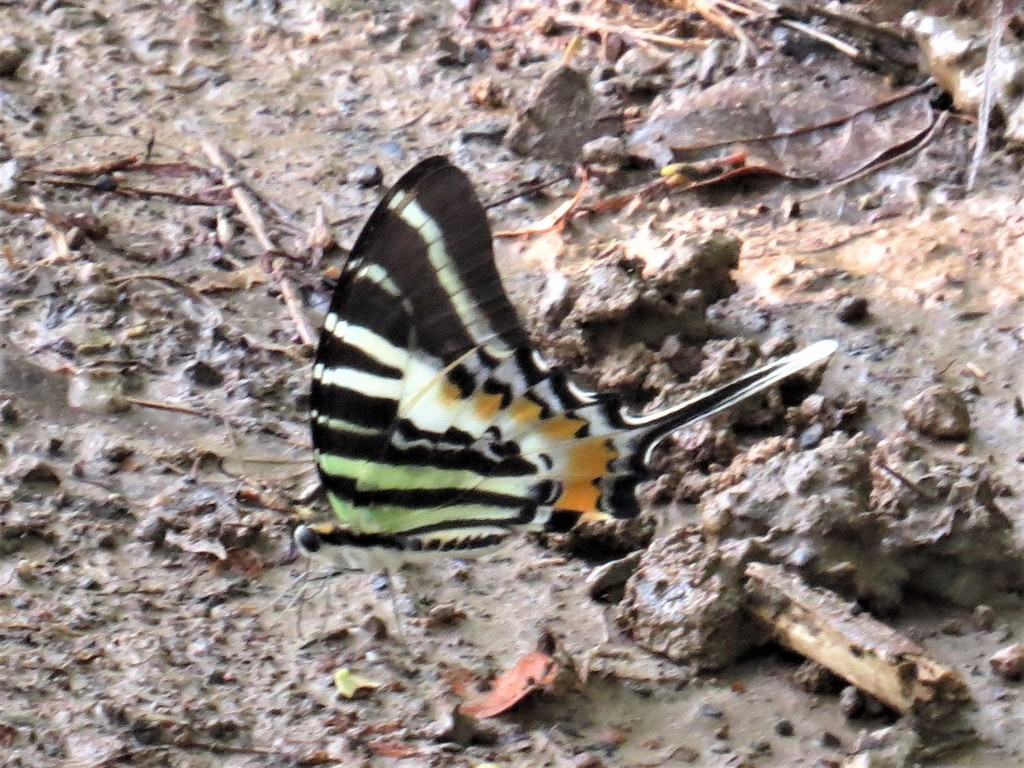Graphium epaminondas, the Andaman Swordtail, is a rare species found only on India's Andaman islands. In fact, it may be resident only on one island, South Andaman. The question is whether to classify it as vulnerable, threatened, or endangered. It has only ever been reported on the islands and has been numerous only in a few specific places. Its population, never very large, is clearly decreasing due to human activity, but how much protection does it need?
Americans see it as beautiful; it looks like a Zebra Swallowtail, only bigger, with more orange than blue undertones in its colors. It's described as black or brown, white, and orange, rather than black, pale blue or green, and red. (Funet.fi has both Oberthur's and Wood-Mason's detailed descriptions, so precise that a person who had never seen the butterfly could color in an outline and achieve a reasonable likeness.) Its wingspan is typically about four inches. Males and females look similar.
Photo by Parthasarathy Gopalan, taken in September on South Andaman. This was the only photo of a living butterfly showing its upper wings that a Google search pulled up. It loaded very slowly for me. If it's not showing up on your screen, you can try right-clicking on the space where the photo should be and clicking on "Load image" when the menu shows up. Alternatively, you may be able to see it at https://www.ifoundbutterflies.org/graphium-epaminondas , but that site did not load for me on the first try, either.
It has been given a few different names. The genus was originally lumped into Papilio; some now split it into Pathysa, which is currently listed as a sub-genus name. The species has been lumped in with antiphates and has been called laestrygonum or laestrigonum or laestrygonium. It was described in 1880, when naturalists were starting to run low on names of heroes of literature to give to Swallowtail butterflies. The naturalist who called it laestrygonum, J. Wood-Mason, explained that because it looked like Graphium antiphates, which was named after an ancient king, he called this species after Antiphates' territory; before publishing his description of the butterfly under this name, he had read Oberthur's description of Graphium epaminondas and was sure it was the same butterfly, but he wasn't sure which description had been offered to the world first. Nineteenth century naturalists determined that Oberthur's description was written first, so the species has been properly known as epaminondas ever since.
Some of us are familiar with a twentieth century picture book character called Epaminondas who was our best known version of a character found in folktales around the world--the very young or foolish person who manages to do each task wrong by following instructions he was given for the previous task. This week's butterfly was, of course, named for an ancient Greek character, a defeated war chief of the city of Thebes. This historical Epaminondas was recognized by his victorious opponents as smart, brave, tough, and the "lover" of another Theban war chief, Pelopidas.
The most obvious threat to Graphium epaminondas's survival is habitat loss. It lives in forests, where it is known to eat only one host plant, Uvaria rufa. Its life cycle has not been fully documented but it is believed to be monophagous, like Zebra Swallowtails, living in symbiosis with one plant species. As increasing human populations eat away the forests, the butterflies and their host plants are in decline.
This species is popular; despite its threatened status, allegedly old carcasses are still being traded, and it has inspired artists. It has been portrayed on postage stamps.
2018 stamps available from https://www.surinamestamps.com/stamp-issue-programme-2018/ The printed sheet places epaminondas among the Birdwings and Bhutan Glories.





No comments:
Post a Comment